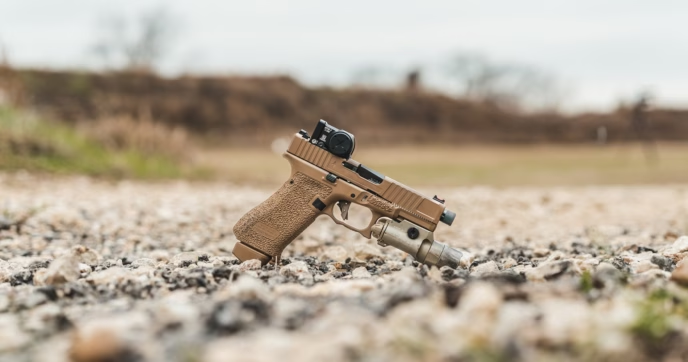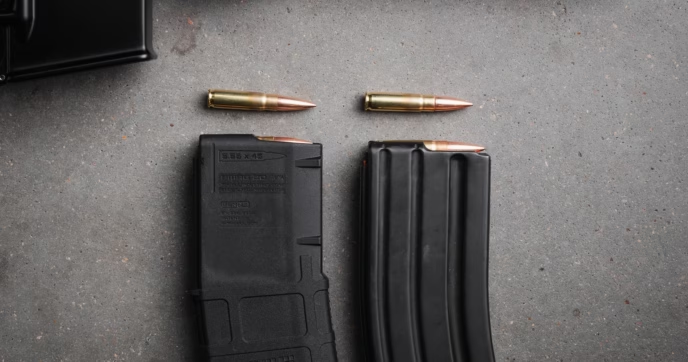The debate between pistols and revolvers has been raging nearly since the two categories were invented and is rife with inaccurate assumptions, personal biases, and plain misinformation. The truth is, there are benefits and drawbacks to both types of handguns, and both have their place and purpose.
Below, we’ll dig into the reality of the dichotomy. We’ll be looking at these two types of firearms primarily from a self-defense and concealed carry perspective—if you’re looking for a gun for range use or competition, you can simply pick whatever interests you the most and be on your way. When your personal safety is at stake, though, it’s worth taking the time to parse out the pros and cons.

Understanding the Differences
Firstly, it’s important to define the difference between categories in order to compare them meaningfully.
“Pistols” encompasses any firearm in which the chamber is an integral part of the barrel. While the word generally calls to mind semi-automatic, magazine-fed firearms, even a breech-loaded single-shot firearm can be a pistol. For the purposes of this article, though, when we talk about pistols, we’re referring to modern, semi-automatic guns.
“Revolver” essentially refers to the inverse—any firearm in which the chamber is not an integral part of the barrel, and is instead contained within a rotating cylinder. Revolvers can be either single- or double-action, depending on whether or not the trigger is capable of both cocking and releasing the hammer or merely releasing it.
For this article, we will be concerning ourselves only with modern double-action revolvers. While single-action guns do still have their place, the vast majority of self-defense scenarios are best served by pistols or double-action revolvers. For more information on single-action vs double-action revolvers, we recommend our guide on the subject.

Pros and Cons
Every firearm on the market has its unique advantages and disadvantages. Choosing the right one for you is a matter of weighing these pros and cons, considering how they relate to your needs and circumstances, and balancing those features you prioritize most against the drawbacks you can learn to live with.
Pistol Advantages
Most of the advantages of a semi-auto pistol are self-evident and well-known. They are in most cases higher capacity than revolvers, faster to reload, faster to fire, and usually, easier to learn to fire accurately.
This is why you will most often see pistols rather than revolvers in the holsters of police officers across the country. The simple fact is, for most defensive applications, whether defense of self or in the case of police officers, defense of others, pistols are the superior choice.
Beyond the above advantages, pistols also tend to be easier to accessorize with common defensive upgrades. While optic-ready revolvers do exist, the selection is dismal compared to the vast array of optic-ready pistols. Similarly, a few revolvers feature rails to which the user could mount a weapon light, but nearly all pistols have at least one or two compatible lights.
Pistol Drawbacks
Still, no firearm is without its limitations. Pistols have more controls than revolvers, which can be confusing for those brand-new to the use of firearms. Whereas a revolver typically has only two controls—a trigger and a cylinder release—a semi-auto pistol will have a trigger, slide lock, mag release, and possibly a safety or decocker as well.
Pistols are simply more complicated to operate than revolvers. There are more steps involved in loading and charging them, and more things that can go wrong.
This leads us to our next drawback—malfunctions.
The majority of firearm malfunctions are induced by one of three things: faulty ammunition, faulty magazines, or a faulty user. While other causes such as mechanical failure do occur, they are vanishingly rare compared to the aforementioned three.
Luckily, with a semi-automatic firearm, malfunctions induced by these most common three causes can usually be cleared in a matter of seconds.
One other source of malfunctions unique to pistols comes from retention positions. A retention position is a specialized grip and stance used to protect the firearm from an assailant attempting to seize it. Firing from the position requires the pistol to be fired very close to the body, which can cause it to become entangled with clothing or have the slide stopped by contact with the body.
For most users, this is a non-issue—the average handgun user doesn’t train to fire from a retention position and the vast majority of users will never have to do so defensively—but for professional users, it may be worth considering.
Revolver Advantages
While an older (and some would say outdated) design, revolvers still have certain advantages that cannot be denied. Chief among them is their simplicity and legendary reliability.
Most revolvers are dead simple to operate. There are no safeties to consider or controls to actuate. Simply point the firearm at the target and pull the trigger until you hear the bang. This simplicity makes them exceptionally easy to learn to use, but unfortunately also makes them hard to master.
Their reliability, on the other hand, is nothing but an asset. Of the aforementioned three most common causes of malfunctions, revolvers are proof against two of them. They do not have magazines and so cannot have a magazine-related malfunction, and faulty ammo does not induce a failure in a revolver, since the user can simply pull the trigger again to rotate out the bad ammunition and fire a fresh cartridge.
Revolvers also have the benefit of being easier to fire in close proximity to your person, such as from a retention position. Since they have no slide to cycle, the risk of jamming on clothing is significantly lower. Some hammerless revolvers can even be fired from within a pocket or bag.
Revolver Drawbacks
The primary drawbacks of revolvers are the same as the advantages of pistols: capacity, reload speed, and fire rate. Revolvers rarely hold more than six or seven cartridges, and while there are exceptions, the average user is going to fire a heavy, double-action trigger much more slowly than the comparatively short and light trigger of the average striker-fired gun.
Similarly, while there are unquestionably those who can reload a revolver using a speed loader or strip with comparable speed to a semi-auto, the average concealed carrier is never going to achieve that level of mastery. For most users, reloading a revolver takes considerably longer than a semi-auto.
Additionally, reloading a revolver involves much finer motor skills, which may be compromised by adrenaline or stress. Reloading a pistol is a simple matter of cramming a single large object into a relatively large opening, then actuating the slide release, or racking the slide if the former is too fine an action. Reloading a revolver, on the other hand, means lining up multiple rounds with their respective chambers and fitting them in, as well as actuating any necessary controls on a speedloader, if using one. This makes revolvers considerably more difficult to load under stress and increases the chances of failure.
Revolvers also tend to be more difficult to fire accurately for the average user. The heavy, double-action trigger makes accurate marksmanship more challenging, although it certainly can be mastered with time and effort.
Lastly, revolvers tend to be more difficult to fit with weapon lights or modern red dot optics. As these sorts of accessories become more and more common, this drawback becomes more pronounced.

Which Should You Choose?
For personal defense and concealed carry, the answer for most people should be a reliable, modern semi-automatic pistol. There is a reason they have become more or less the standard for both professional and civilian users. Semi-automatics are slightly more complicated to learn to operate, but still simple enough to be learned in an afternoon and mastered in a matter of months with diligent practice.
Pistols offer the benefits of increased capacity, faster reload times, and superior rate of fire, in addition to being easily outfitted with common defensive accessories. The lighter, shorter trigger pull of the average striker-fired pistol makes accurate marksmanship considerably easier for users who have not had extensive practice, as well.
With that said, revolvers still have their place. Revolvers are an excellent choice for those already familiar with their operation and capable of firing them accurately. With enough practice, their limitations to rate of fire and reload speed can be mitigated.
Revolvers also offer compelling advantages for certain niche situations, such as firing from a retention position, or from pocket carry in a heavy cold-weather coat. While these are relatively uncommon scenarios, they may still be applicable for professional users or those in extremely cold weather climates.

Conclusion
Both revolvers and pistols have their place, but most users are going to be best served by a pistol for personal and home defense applications. Pistols offer practical advantages that can’t be matched by revolvers, but revolvers do still offer certain benefits that can be highly valuable in certain scenarios.
Once you’ve chosen the best handgun for you, we recommend taking a look at our guide to pistol calibers to help understand which cartridge is going to best suit your purposes as well.



